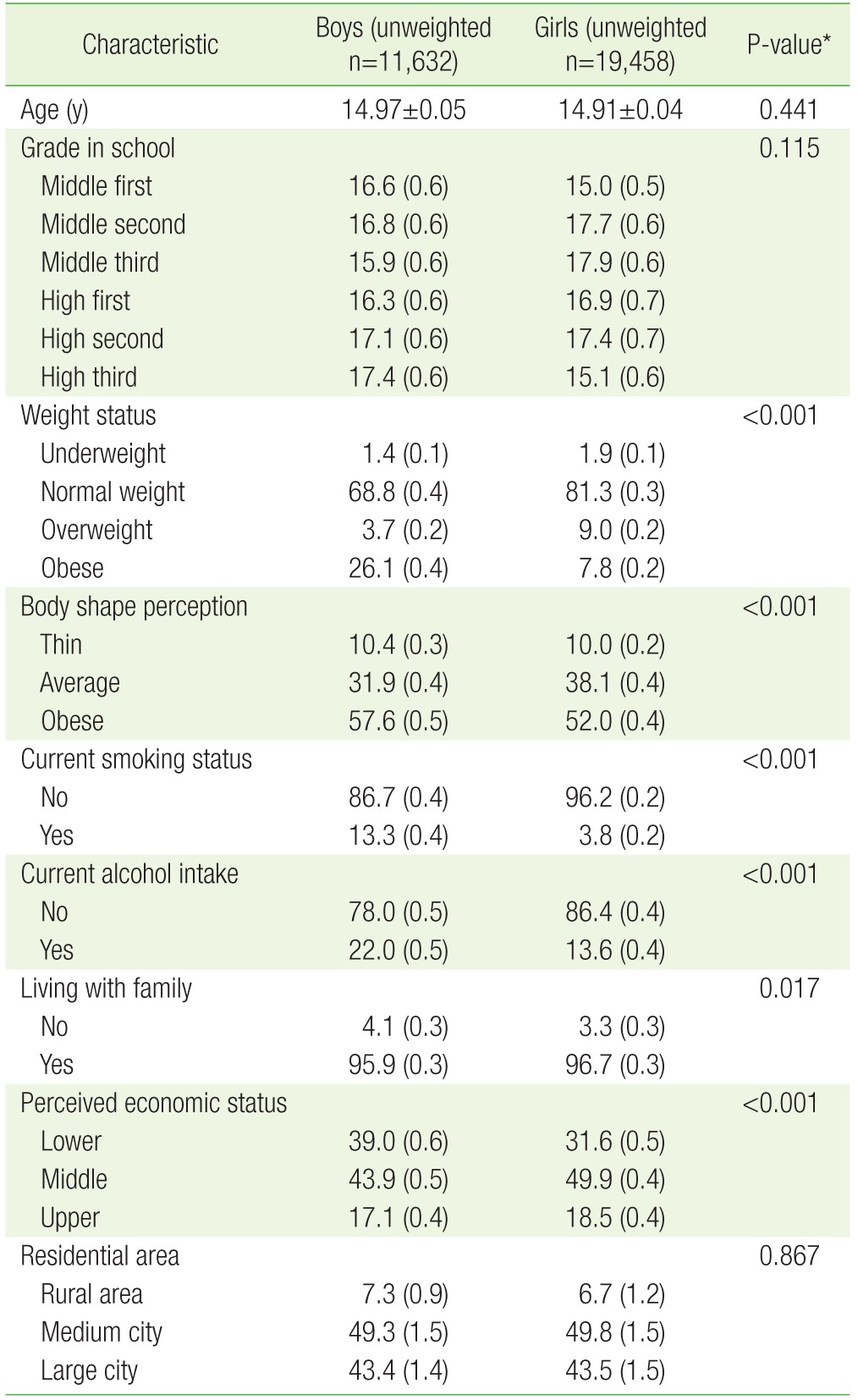1. Park NH, Lee HJ. A critical review of health behavior studies of adolescents conducted in Korea. J Korean Community Nurs 2002;13:98-114.
2. Jee YJ, Kim YH. A structural model for health risk behavior of late adolescents: based on 2010 Korea Adolescent Health Survey. J Korean Acad Nurs 2014;44:179-188. PMID:
24859123.


3. Korea Centers for Disease Control and Prevention. The Tenth Korea Youth Risk Behavior Web-Based Survey, 2014. Cheongju: Korea Centers for Disease Control and Prevention; 2014.
5. Kim DS, Cho Y, Cho SI, Lim IS. Body weight perception, unhealthy weight control behaviors, and suicidal ideation among Korean adolescents. J Sch Health 2009;79:585-592. PMID:
19909422.


6. Oh D, Kim E, Kim S. Weight control behaviors and correlates in Korean adolescents. J Korea Contents Assoc 2013;13:218-228.

7. Neumark-Sztainer D, Story M, Dixon LB, Murray DM. Adolescents engaging in unhealthy weight control behaviors: are they at risk for other health-compromising behaviors? Am J Public Health 1998;88:952-955. PMID:
9618628.



8. French SA, Perry CL, Leon GR, Fulkerson JA. Weight concerns, dieting behavior, and smoking initiation among adolescents: a prospective study. Am J Public Health 1994;84:1818-1820. PMID:
7977924.



9. Potter BK, Pederson LL, Chan SS, Aubut JA, Koval JJ. Does a relationship exist between body weight, concerns about weight, and smoking among adolescents?: an integration of the literature with an emphasis on gender. Nicotine Tob Res 2004;6:397-425. PMID:
15203775.



10. French SA, Jeffery RW. Weight concerns and smoking: a literature review. Ann Behav Med 1995;17:234-244. PMID:
24203535.


11. Rhee D, Yun SC, Khang YH. Co-occurrence of problem behaviors in South Korean adolescents: findings from Korea Youth Panel Survey. J Adolesc Health 2007;40:195-197. PMID:
17259067.


12. Moon JS, Lee SY, Nam CM, Choi JM, Choe BK, Seo JW, et al. 2007 Korean National Growth Charts: review of developmental process and an outlook. Korean J Pediatr 2008;51:1-25.

13. Eaton DK, Lowry R, Brener ND, Galuska DA, Crosby AE. Associations of body mass index and perceived weight with suicide ideation and suicide attempts among US high school students. Arch Pediatr Adolesc Med 2005;159:513-519. PMID:
15939848.


14. Johnson JL, Eaton DK, Pederson LL, Lowry R. Associations of trying to lose weight, weight control behaviors, and current cigarette use among US high school students. J Sch Health 2009;79:355-360. PMID:
19630869.


15. Neumark-Sztainer D, Wall M, Eisenberg ME, Story M, Hannan PJ. Overweight status and weight control behaviors in adolescents: longitudinal and secular trends from 1999 to 2004. Prev Med 2006;43:52-59. PMID:
16697035.


16. Crow S, Eisenberg ME, Story M, Neumark-Sztainer D. Suicidal behavior in adolescents: relationship to weight status, weight control behaviors, and body dissatisfaction. Int J Eat Disord 2008;41:82-87. PMID:
17922538.


17. Klesges RC, Robinson LA, Zbikowski SM. Is smoking associated with lower body mass in adolescents?: a large-scale biracial investigation. Addict Behav 1998;23:109-113. PMID:
9468748.


18. Klesges RC, Elliott VE, Robinson LA. Chronic dieting and the belief that smoking controls body weight in a biracial, population-based adolescent sample. Tob Control 1997;6:89-94. PMID:
9291216.



19. Jones N. Relationship of BMI and weight perception to weight controlling behaviors in 9th-12th graders in the United States [dissertation]. Lexington (Ken): University of Kentucky; 2015.
22. Simantov E, Schoen C, Klein JD. Health-compromising behaviors: why do adolescents smoke or drink?: identifying underlying risk and protective factors. Arch Pediatr Adolesc Med 2000;154:1025-1033. PMID:
11030855.


23. Takakura M, Nagayama T, Sakihara S, Willcox C. Patterns of health-risk behavior among Japanese high school students. J Sch Health 2001;71:23-29. PMID:
11221536.


24. Ellickson PL, Tucker JS, Klein DJ. High-risk behaviors associated with early smoking: results from a 5-year follow-up. J Adolesc Health 2001;28:465-473. PMID:
11377990.


25. Parra-Medina DM, Talavera G, Elder JP, Woodruff SI. Role of cigarette smoking as a gateway drug to alcohol use in Hispanic junior high school students. J Natl Cancer Inst Monogr 1995;(18):83-86. PMID:
8562226.

26. Prattala R, Karisto A, Berg MA. Consistency and variation in unhealthy behaviour among Finnish men, 1982-1990. Soc Sci Med 1994;39:115-122. PMID:
8066482.


27. Jessor R. Risk behavior in adolescence: a psychosocial framework for understanding and action. J Adolesc Health 1991;12:597-605. PMID:
1799569.


28. Irwin CE Jr, Igra V, Eyre S, Millstein S. Risk-taking behavior in adolescents: the paradigm. Ann N Y Acad Sci 1997;817:1-35.

29. Park S, June KJ. The importance of smoking definitions for the study of adolescent smoking behavior. J Korean Acad Nurs 2006;36:612-620.

30. Lee S, Grana RA, Glantz SA. Electronic cigarette use among Korean adolescents: a cross-sectional study of market penetration, dual use, and relationship to quit attempts and former smoking. J Adolesc Health 2014;54:684-690. PMID:
24274973.














